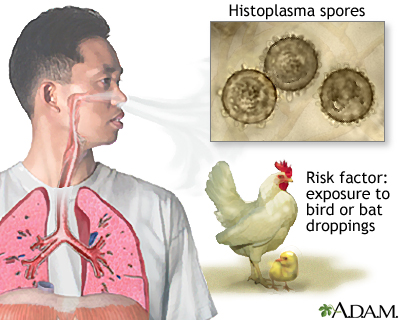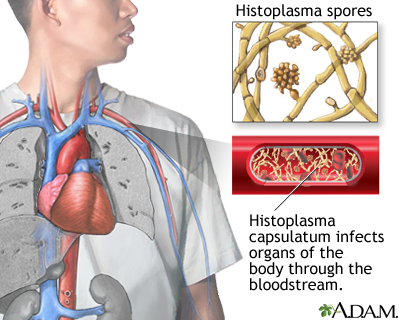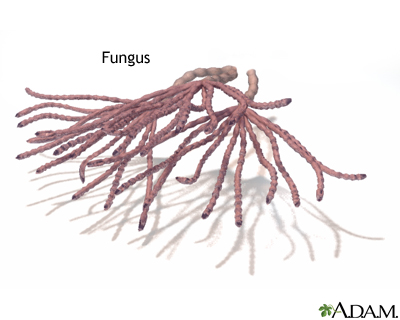Health Library
Histoplasmosis
Fungal infection - histoplasmosis; Ohio River Valley fever; Fibrosing mediastinitis
Histoplasmosis is an infection that occurs from breathing in the spores of the fungus Histoplasma capsulatum.
Images





I Would Like to Learn About:
Causes
Histoplasmosis occurs throughout the world. In the United States, it is most common in the southeastern, mid-Atlantic, and central states, especially in the Mississippi and Ohio River valleys.
Histoplasma fungus grows as a mold in the soil. You may get sick when you breathe in spores produced by the fungus. Soil that contains bird or bat droppings may have larger amounts of this fungus. The threat is greatest after an old building is torn down, or in caves.
This infection can occur in people with a healthy immune system. But, having a weakened immune system increases the risk of getting or reactivating this disease. Very young or very old people, or those with HIV/AIDS, cancer, or an organ transplant have more severe symptoms.
People with long-term (chronic) lung disease (such as emphysema and bronchiectasis) are also at higher risk for a more severe infection.
Symptoms
Most people have no symptoms, or only have a mild, flu-like illness.
If symptoms do occur, they may include:
- Fever and chills
- Cough and chest pain that gets worse when breathing in
- Joint pain
- Mouth sores
- Red skin bumps, most often on the lower legs
The infection may be active for a short period of time, and then the symptoms go away. Sometimes, the lung infection may become chronic. Symptoms include:
- Chest pain and shortness of breath
- Cough, possibly coughing up blood
- Fever and sweating
In a small number of people, especially in those with a weakened immune system, histoplasmosis spreads throughout the body. This is called disseminated histoplasmosis. In response to the infection irritation and swelling (inflammation) occur. Symptoms may include:
- Chest pain from inflammation of the sac-like covering around the heart (pericarditis)
- Headache and neck stiffness from swelling of the membranes covering of the brain and spinal cord (meningitis)
- High fever
Exams and Tests
Histoplasmosis is diagnosed by:
- Biopsy of the lung, skin, liver, or bone marrow
- Urine or blood tests to detect histoplasmosis proteins or antibodies
- Cultures of the blood, urine, or sputum (this test provides the clearest diagnosis of histoplasmosis, but results can take 6 weeks)
To help diagnose this condition, your health care provider may do a:
- Bronchoscopy (test that uses a viewing scope inserted into the lung airway to check for signs of infection)
- Chest CT scan
- Chest x-ray
- Spinal tap to look for signs of infection in cerebrospinal fluid (CSF)
Treatment
In otherwise healthy people, this infection usually goes away without treatment.
If you are sick for more than 1 month or are having trouble breathing, your provider may prescribe medicine. The main treatment for histoplasmosis is antifungal drugs.
- Antifungals may need to be given through a vein, depending on the form or stage of disease.
- Some of these medicines can have side effects.
- Long-term treatment with antifungal drugs may be needed for up to 1 to 2 years.
Outlook (Prognosis)
The outlook depends on how severe the infection is, and your general health condition. Some people get better without treatment. An active infection will usually go away with antifungal medicine. But, the infection may leave scarring inside the lung.
The death rate is higher for people with untreated disseminated histoplasmosis who have a weakened immune system.
Possible Complications
Scarring in the chest cavity may put pressure on the:
- Major blood vessels carrying blood to and from the heart
- Heart
- Esophagus (food pipe)
- Lymph nodes
Enlarged lymph nodes in the chest may press on body parts such as the esophagus and blood vessels of the lungs.
When to Contact a Medical Professional
Call your provider if you live in an area where histoplasmosis is common and you develop:
- Flu-like symptoms
- Chest pain
- Cough
- Shortness of breath
While there are many other illnesses that have similar symptoms, you may need to be tested for histoplasmosis.
Prevention
Histoplasmosis may be prevented by reducing exposure to dust in chicken coops, bat caves, and other high-risk locations. Wear masks and other protective equipment if you work in or go into these environments.
Related Information
BronchiectasisHIV/AIDS
Pericarditis
Mediastinitis
Meningitis
References
Deepe GS. Histoplasma capsulatum (histoplasmosis). In: Bennett JE, Dolin R, Blaser MJ, eds. Mandell, Douglas, and Bennett's Principles and Practice of Infectious Diseases. 9th ed. Philadelphia, PA: Elsevier; 2020:chap 263.
Kauffman CA, Galgiani JN, Thompson GR. Endemic mycoses. In: Goldman L, Schafer AI, eds. Goldman-Cecil Medicine. 26th ed. Philadelphia, PA: Elsevier; 2020:chap 316.
BACK TO TOPReview Date: 12/24/2020
Reviewed By: Jatin M. Vyas, MD, PhD, Assistant Professor in Medicine, Harvard Medical School; Assistant in Medicine, Division of Infectious Disease, Department of Medicine, Massachusetts General Hospital, Boston, MA. Also reviewed by David Zieve, MD, MHA, Medical Director, Brenda Conaway, Editorial Director, and the A.D.A.M. Editorial team.
 | A.D.A.M., Inc. is accredited by URAC, for Health Content Provider (www.urac.org). URAC's accreditation program is an independent audit to verify that A.D.A.M. follows rigorous standards of quality and accountability. A.D.A.M. is among the first to achieve this important distinction for online health information and services. Learn more about A.D.A.M.'s editorial policy, editorial process and privacy policy. A.D.A.M. is also a founding member of Hi-Ethics. This site complies with the HONcode standard for trustworthy health information: verify here. |
The information provided herein should not be used during any medical emergency or for the diagnosis or treatment of any medical condition. A licensed medical professional should be consulted for diagnosis and treatment of any and all medical conditions. Links to other sites are provided for information only -- they do not constitute endorsements of those other sites. © 1997- 2021 A.D.A.M., a business unit of Ebix, Inc. Any duplication or distribution of the information contained herein is strictly prohibited.
